
Overview
Skyscrapers are defined as being at least 330 feet (100 meters) high with supertalls classified as 984 feet (300 meters) and mega tall at 1,968 feet (600 meters) or higher.
From the Burj Khalifa in Dubai to the Shanghai Tower in China and the Empire State Building in New York, there is no doubt that these structures are a marvel of modern engineering and they stand as a testament to human ingenuity and perseverance. For architects and engineers, the challenge to design them is complex.
From the foundation to the roof, they are carefully planned and executed by scivi engineers, which might take years to complete before even one brick is laid down. Considerations towards building codes, structural stability, aesthetics, and of course economics are primary factors to be studied.
Exploring the making of skyscrapers is an exciting journey for anyone interested in how tall buildings are constructed. This article is a credit to the dedication to the architects and engineers who build them.
Enter the Forces of Nature
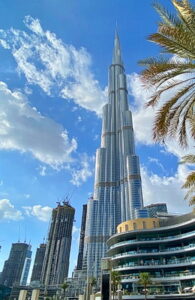
Wind loads (wind forces) that hit the buildings can cause them to sway. The higher the building is, the more wind it will be subject to.
Skyscrapers will sway and can easily move several feet in either direction.
To reinforce the structure to withstand these winds, there are several options that engineers will use.
Empire State Building – A Prime Example of Mitigating Wind Forces
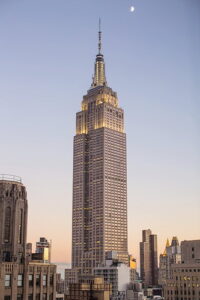
Before we delve into the engineering specifics, let’s get familiar with the general idea of how buildings suppress wind forces and what better example to use than the famous Empire State Building?
Most tall buildings use multiple methods to mitigate strong winds, so let’s take a look at what engineers have done with this 1,472-foot-high iconic structure.
- Streamlined shape: The building has a tapered shape that reduces wind resistance and helps to distribute wind forces evenly across the building. More commonly known as setbacks.
- Wind bracing: The building has a series of steel braces that run diagonally between the exterior columns, which helps to provide additional support and stability against wind forces.
- Corner columns: The building’s corner columns are larger and stronger than the interior columns, which helps to distribute wind forces more evenly throughout the building.
- Tuned mass damper: The building has a large pendulum-like device called a tuned mass damper located on the 58th floor. The damper helps to counteract wind-induced building oscillations by moving in the opposite direction of the building’s sway, effectively damping out the oscillations.
Now let’s take a look at the process from start to finish.
Designing the Structure
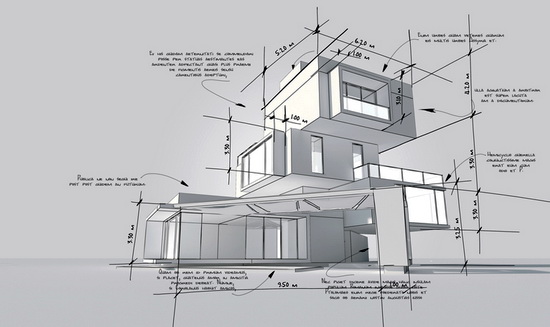
Economics always comes into play, so whatever the planned design is, it must be within the developer’s budget. Architects use computer-aided design (CAD) software to create 3D models of a building.
Usually created on networked desktop computers, CAD is used primarily for analyzing and optimizing a building’s design.
Of course with skyscrapers, there may be hundreds of CAD diagrams that would be needed. The software includes the building codes that they must follow.
Building the Foundation

It should go without saying that structural stability is of the utmost importance and the foundation is the first step in helping to buttress the building from the forces of nature to which these buildings may be subject.
Beginning with the foundation, engineers must determine if the soil below the building is strong enough to support the structure. A good example is in New York City where there is solid bedrock that makes it perfect for the construction of skyscrapers.
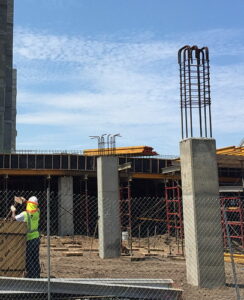
Steel and concrete are the most commonly used materials for foundations. Concrete is strong under compression, but not as strong under tension, and in its pure form, it is unsuitable to withstand the stresses of the wind forces and vibrations,
To compensate for this lack of tensile strength, workers pour a liquid concrete mixture into a wire mesh steel frame, called rebar or reinforcing bar, which strengthens the tension component of the concrete. Together, the product is known as reinforced concrete and forms a strong solid foundation to support any tall building.
Strong Internal Cores
One of the most popular methods for mitigating wind forces is the ability to build strong cores in the center of the building. Usually constructed around the elevators are solid steel and/or concrete trusses, braced by steel beams.
Most of the tall buildings of the 20th century use this method and it is still going strong into the 21st century, but usually, there are more obstacles to the wind added, especially if the building is of the super or mega tall variety.
Corner Softening
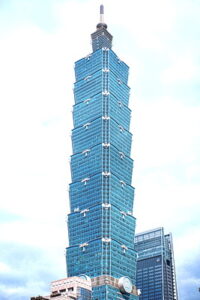
This is a style that softens the edges of tall buildings to reduce the vortices (strong winds) that these structures are subject to.
The 1,667-foot Taipei 101 in Taiwan uses this method which is very effective in controlling high winds.
But that’s not all Taipei 101 uses against wind vortices as we will see below.
Setbacks
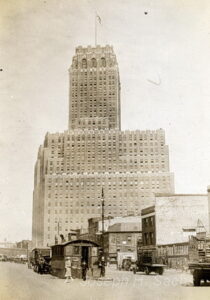
In 1916, due to the shadow effect that tall buildings would leave on the sidewalks of New York, specifically, the 555-foot tall Equitable Building that was completed a year before, a new zoning law was enacted that would force developers to apply setbacks to all tall buildings.
New York City’s Empire State Building and Chrysler Building are excellent examples of setback design, as well as examples of the esthetic beauty of the art deco structures of that time.
Not only were setbacks desirable but, from an engineering point of view, they helped to diminish the harsh winds that tall buildings were subjected to.
Twisting
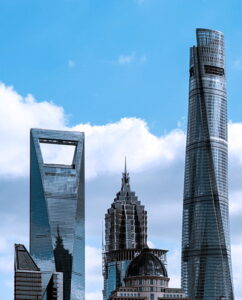
Spiraling skyscrapers are becoming more popular. Not just for their aesthetic appeal, but also because of their ability to reduce wind vortexes by up to 24%.
For the Shangai Tower, this resulted in a reduction of $58 million that the developers did not have to add to buttress the building.
Even more, aesthetically pleasing is the 1,417-foot tall Diamond Tower in Jeddah, Saudi Arabia. If that’s not intriguing enough, there is the 1,273-foot Dubai Tower that not only twists but also rotates 360 degrees. Built by Italian/Israeli architect David Fisher of Dynamic Architecture, the building gives spectators and residents alike an ever-changing view of the Dubai skyline.
Tubular System
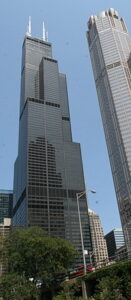
The Willis Tower in Chicago is an excellent example of a building that employs the tubular method for addressing wind forces.
This super tall consists of a collection of nine tubes supporting each other, subsequently buttressing the building to fight off the winds more than if it was just one straight up-and-down structure.
Additionally, since they level off at different heights, the wind forces are inherently disrupted.
Cutout
A less used method but efficient nonetheless. The wind is allowed to pass through specific areas of a building. which reduces the wind loads on the building. Below is an animation demonstrating how the building negotiates the wind forces using cutouts on various floors.
When employing the cutout wind method, other methods of wind optimization are used along with it. New York’s 432 Park Ave makes use of this system. Additionally, the building uses the tuned mass damper system as described in the next section.
Tuned Mass Damper (TMD) (AKA harmonic absorber)
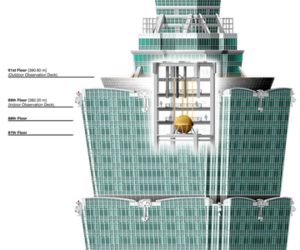
Large, heavy dampers, usually near the top of the building compensate for building vibrations, such as high winds. Similar to a pendulum that sways back and forth, these dampers will move against the wind thereby stabilizing the building.
In technical terms, the mass damper is designed to work in harmony with the oscillation frequency of the building from the wind, thereby reducing the overall sway of the structure.
Combination of the Above
Many times, a multiple of these strategies are used to tackle the vortices, and in so doing, they can be very effective in taming the wind.
Constructing the Superstructure
The superstructure is the actual building, more specifically, it is the framework that connects the foundation to the roof, and this is where the CAD model is pertinent. The CAD model will help to identify the best location for the support columns, known as the centroid.
Engineers will select the most economical material and size of steel for these columns. They must also ensure that the columns are spaced far enough to resist both wind and potential seismic forces. Consideration will go into the type of concrete material and the size of the floor slabs, based on how much weight the slabs must support.
They must also consider the thickness of the slabs based on the amount of deflection allowed by the building codes, but we’ll leave the details of these considerations to another article that provides the specifics of these components.
Structural Engineering in a Nutshell
Watch this video which lays out the concepts of the engineering techniques required to build a tall building.
Summary
The engineering behind the making of skyscrapers is a complex and lengthy journey. When engineers design a supertall, they must consider many different aspects of the project. They must select materials that can withstand the forces of nature such as high winds, heavy precipitation, and even earthquakes.
They must also ensure that the building is structurally sound. In today’s skyscrapers, you can rest assured that the hard work and dedication that was put into each of these buildings by the architects, engineers, and construction workers make these buildings sound and secure.
